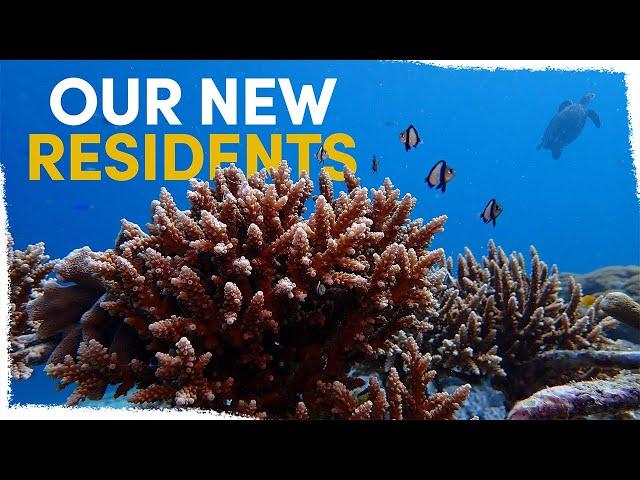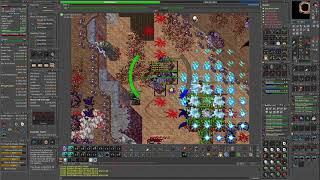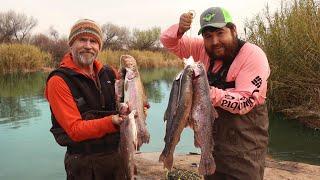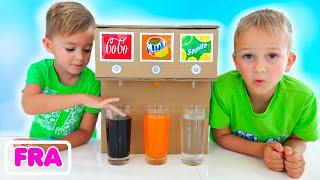
Our new residents and exploring our next site | VLOG
🪸 To support our work you can become a member here: https://mossy.earth
MOSSY EARTH MEMBERSHIP
===============================
The rewilding membership that restores nature across a wide range of ecosystems.
🌲 Support a diversity of ecosystems
🐺 Rewild habitats to bring back biodiversity
🦫 Fund neglected species & ecosystems
🙌 And if you are already a member, you can pay for an extra structure (or more!) to be deployed here: https://www.mossy.earth/platform/fund-extra-campaigns/10
CORAL ATTACHMENT RESEARCH
===============================
https://www.researchsquare.com/article/rs-2729419/v1
https://enviromicro-journals.onlinelibrary.wiley.com/doi/full/10.1111/1758-2229.13229
https://reefscapers.com/coral-attachment-experiments/
USEFUL LINKS
===============================
🌲 Mossy Earth main YouTube Channel - https://www.youtube.com/@MossyEarth
Curated in-depth videos about our various rewilding projects.
📝 Field notes channel - https://www.youtube.com/@MossyEarth-FieldNotes/videos
Regular on the ground videos covering our progress across various projects.
📣 Mossy Earth Podcast
Spotify: https://open.spotify.com/show/09TpKCZi4ho5UyxNP1pbJp
Apple podcasts: https://podcasts.apple.com/gb/podcast/mossy-earth-podcast/id1767621626
RSS feed: https://anchor.fm/s/faea4c14/podcast/rss
ABOUT THIS PROJECT
===============================
Coral reefs are known as “the rainforests of the sea”. These vibrantly complex ecosystems harbour the highest biodiversity of any ecosystem globally. An estimated 25% of all marine species depend on reefs. They are also crucial for millions of people, providing food, livelihoods, resources and coastal protection.
Major threats, such as over-exploitation and climate change, are jeopardising the future of coral reefs. In the last few decades, sharp declines in reef cover have occurred worldwide. This is our first coral reef project to restore damaged reefs in the northern waters of Nusa Penida, Indonesia.
Our long-term goal is to improve resilience by enhancing connectivity of fragmented reefs whilst protecting and preserving endangered coral species. Led by our local team of expert divers and marine biologists passionate about the preservation of this marine ecosystem, we work with local people to promote positive community involvement in coral reef restoration.
You can learn more about this project (including FAQs) by visiting: https://www.mossy.earth/projects/building-resilient-coral-reefs?utm_source=field_notes&utm_medium=youtube&utm_campaign=coral-vlog_2024-11-06
Комментарии:

I wonder if the slower growing corals will get overgrown by the faster growing ones in the future.
Do you have research from other restoration projects about that?
Would it would be wise to create islands of slower growing corals to avoid this issue?

What are the options of building caves/tunnels as well as the cages to add variance to the areas
Ответить
Loving seeing the coral grow and the regular updates! Keep going team!
Ответить
I love this project and it is marvelous to see the impact from the first area🪸💙🪸 I have bought two structures through the 'fund extra' campaign and encourage others to follow suit if you can💪🏻 Let the reefs thrive again🙌🏻
I also like the idea of different structural heights in itger comments👌🏻😉

In the US and needed this reminder that people all around the world are working to help our planet. Thanks for the update!
Ответить
Hello there, great update! I'm glad to see the project progress fairly well.
I have been keep coming back to the question of attachment material when it occurred to me, that rubber bands made from natural resources like latex or rubber are bio degradable. They come in various sizes and strengths. Adding them during the assembling process of the structure, would mean, that they be already attached during the placement and the corals would only need to be twisted into place using the band.
Now I don't know how well this would work, what strength you would need etc. =) But since you guys do try different materials, this might be another one to add to the ever growing list.
Keep up the amazing work!

Seems like quite a lot of the cable ties still have their tabs attached, I thought you were removing those and recycling them?
Ответить
Very cool stuff! Excited to see how the project evolves. Cant wait to see the area fully grown with coral!
Ответить
This is kind of hopeful video I need right now, thank you so much for the amazing updates <3
Ответить
Thanks for the update!
Ответить
Love this project!
We want more! and more!

Thanks for the frequent updates, it allows us to see how quickly the corals grow and it makes me happy to see that progress. I also agree with adding some additional hights, which could be easily done by welding 2 or 3 of the existing segments above each other making a pile. Creating such isles would not only please our eyes but also the fishes. Maybe having someing like a amphora would be great for fishes who like to stay in caves :) And I would expect that on a surface like that, corals would attach themselves. But anyway, its all a learning process and your project should be adopted on a larger scale with government support. Corals bind carbon dioxide after all. Having nice reefs and a healthy fish population will also support the locals, maybe some convincing work for blast fishers would be helpful too. Destroying the reefs will hurt them too in the long run.
Ответить
Love these coral Vlogs❤
Ответить
It is amazing to see the progress, keep up the good work, can’t wait for the upgraded boat. Thanks for the update, bersulang!
Ответить
It might be worth to try to include some protected microhabitats to the structures, perhaps segments of pipes with various diameters attached to the rebar by metal zipties.The structures are still very open and that won´t change for a whille. Adding more hiding places might accelerate the establshment of stable reef communities, including - if you are lucky - some natural cleanup crew.
Ответить
to Mas Yudi and Team, than you for the update! so proud of you :) as a fellow Indonesian it really makes me happy to see this type of restoration work continuing! I havent been back home in a while but just maybe, if I can get the time, I would love to visit Puramas and see the entirety of it. Maybe donate also<?> not sure if this is possible yet. But anyways, thank you for the update, please continue the efforts. Salam hangat dan semangat terus!
Ответить
I spent a little time on Gili Trawangan on the west side of Lombok a few decades ago.
The blast fishing and broken coral beaches broke my heart.

The coral grows a lot faster than I expected.
Ответить
I have two suggestions.
1. Use mild steel wire to attach the coral. It will hold long enough for the coral to attach, and completely dissolve in a few years.
2. Leave some open lanes of bottom perpendicular to the beach for the bottom dwelling species, and for tide flow.

It looks even more beautiful than last time which is saying a lot
Maybe you should experiment with frame shapes if they are custom made

Putting local oysters in that area would help the reef grow too.
Ответить
I know some people are upset about tying the coral with plastic zip ties. Have you thought about using epoxy or something like roman concrete? Roman concrete gets stronger under water idk how the salt would effect it. I think it's made up of sand, Lyme, and volcanic ash.
Ответить
Fishermans nightmare 😂 imagine how many times your hook gets stuck, awesome work though!
Ответить
You need to make the holes on some of the structures different sizes so the smallest fish can hide from smaller fish, smaller can hide from small, small can hide from normal, normal can hide from big and big can hide from shark. 👏🏾
Ответить
Loving the updates, it's great to see the small "mundane" steady work required to make these great projects happen. It makes it feel more real, and it also gives me motivation to do mundane steady work to make other good things happen.
Ответить
What are the natural predators of the snails? Can you build some habitat for them?
Ответить
Curious to learn more about the snails 'killing' the coral , it's probably a natural proces that happens in healthy reefs but what are your ideas with them later? I don't think it's really time efficient to keep removing them, but maybe their impact is less when the coral is more mature. Interested in hearing your plans on it going forward and keen to learn more. Love the work and the videos!
Ответить
This is truly exciting. Thanks you.
Ответить
If you guys plan to do more coral restoration projects like this, please consider doing so in the Gulf of Mexico along Florida's coast as the reefs there are only 2% of what they where historically!
Ответить
Yup I was right, it's in Indonesia
❤🇮🇩
Mana kawan2 Indonesiaku? Hehe

I wonder what animals are eating the snails on the reef
Maybe adding hiding places on the actual sea floor underneath the metal structures may enable whatever eats the snails to reach the snails safely
Something like a "wildlife corridor" made out of a line of rocks and dead coral fragments that offers hiding places along the route out to the newly established areas

I really adore this project, just wonderful work happening.❤❤❤
Ответить
Good vid, almost at 10,000 subs!
Ответить
Merci pour vos efforts ! Je vois que vous utilisez maintenant du métal pour attacher les coraux. J'avais pensé à la colle utilisée en aquascaping pour coller les végétaux sur le décor. Je ne sais pas si c'est une bonne idée ceci dit en terme écologique aussi bien que pratique. Juste une possible piste de réflexion ?!
Love from Belgium, Shayan

Thank you for the update :)
Ответить
I love watching updates from this project so much
Ответить
I'm in Lembongan at the moment! Do you think is possible to meet the team on the island?
Ответить
every time i go to my garden i get excited about my fruit trees, I can only imagine what they feel when they scuba dive down and check on the new growth.
Ответить
So peaceful and beautiful.
Ответить
I still think a 24/7 livestream of the reef would be really cool. We could see what sorts of fish move in to the area and watch the corals grow over months.
Impressive how big some of those corals have gotten already!

So happy to hear things are going so well and that you guys are expanding! Thought it does make me very sad to hear that blast fishing is still occurring, even if it is further out.😢
Ответить
Have you all ever done a control experiment where you just set out a couple plain star structures without any starter corals affixed? Would be interesting to see if it attracts any life on its own, and to see what corals are able to start growing naturally.
Ответить
Can’t wait to see more ❤
Ответить
Seems like a crazy amount of work to build and assemble each individual little rebar cage. Do you think there might be a way to utilize the sorts of tension-based structures that dry land-bound farmers use to create trellises for grape vines and fences to contain livestock? Seems like they are able to get much more structure out of much less effort and material. Just a thought….
Ответить
I have a special intrest in this project because the challenges it has
Land restoration is camparably easy than this
Thank you for your efforts we will support you 🙏🏻

Wow just found this channel im so excited. Followed mossy earth for a while but now im here too.
Ответить
Your work is so important! Thank you for your efforts from the bottom of my heart
Ответить
I love seeing this!
Ответить
Wonderful work, and excellently described. Many thanks.
Ответить

























